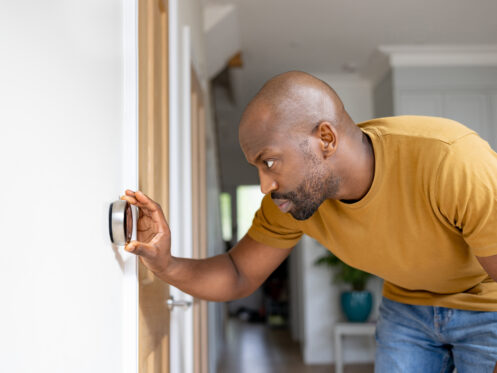Smart thermostats are quickly becoming the go-to choice for many homeowners. They integrate well into a wide range of existing HVAC systems and related technologies. Smart thermostats make homes more efficient and convenient. Homeowners should understand the efficiency benefits that come from installing a smart climate control device. As smart thermostats revolutionize heating and cooling efficiency, look to the following benefits.
Energy Efficiency
By far, the biggest selling point for a smart thermostat for most homeowners is increased energy efficiency. The problem with a traditional thermostat is that you have to set it. It then triggers heating and cooling cycles at the set temperature until you change the temperature again.
What is problematic is that your house probably doesn’t need to be the same temperature all the time. If you’re away at work and no one else is home, your house really does not need to be 72 degrees. Many smart thermostats use sensors to detect a house’s current occupancy level. Based on programmed settings, the smart thermostat can adjust the target temperature. If you’re away during the hottest part of the day in the summer, for example, the smart thermostat might let the house run a big warm to avoid running the air conditioning for more cycles.
The nice part is that other technologies can then help your smart thermostat to respond properly when you’re coming home. No one wants to come home to a house that’s baking in the summer or cold in the winter. Fortunately, many smart thermostats can work with apps on phones or in vehicles to detect when you’re getting close to home. Suppose you’re fifteen minutes out from your house. Your phone can detect that fact using your GPS and relay the information to your smart thermostat. The smart thermostat can then kick up the heating or air conditioning to ensure that your house is comfortable when you get in the door.
Zonal HVAC
An underrated companion to a smart thermostat is a zonal HVAC system. Using a series of vents, dampers, fans and sensors, you can configure the heating and cooling in your home into zones. A similar effect is also possible with a much simpler solution, ductless mini-split systems. Many homeowners set up zones for bedrooms, the living room and the kitchen, for example. The efficiency benefit comes from targeting occupied areas of the house and providing less heating and cooling to unoccupied zones. Especially if you have a couple of largely unused rooms, such as a guest bedroom and a craft room, setting up zones yields excellent efficiency benefits.
Zoning works well enough with standard thermostats, but the benefits go much further when you connect it together with a smart thermostat. Now you have control of the heating and cooling in every part of your house. You don’t have to worry about the climate control in your bedroom until you’re ready to go to sleep. Even better, you can use an app that integrates into your phone or entertainment system to control each zone. Once you’re ready for bed, tell the smart thermostat to get the HVAC running. By the time you’ve brushed your teeth, your bedroom will be perfectly comfortable.
Using a zonal setup also allows you to target HVAC usage more efficiently. In some households, one family member may need significantly different conditions because of a medical problem. For example, some folks require cooler temperatures to avoid aggravating a condition like COPD or asthma, especially when they sleep. If you have a retired parent living with you who needs better control of the HVAC in their part of the house, a smart thermostat is an efficient solution. They can run the HVAC harder in their zone while the other zones remain more efficiency-focused. Also, everyone in the house can then choose their preferred conditions.
Tighter Control
Not every homeowner wants everyone in their house fiddling with the thermostat. With a traditional configuration, it can be tough to stop roommates or children from messing with the temperature. However, a smart thermostat allows tighter control of access to the settings. You can lock out anyone who tends to be problematic from using the thermostat. Similarly, you can grant access. If a visitor is using the guest bedroom, for example, you can grant them access to the smart thermostat. Especially when mixed with a zonal system, this approach can be very effective and efficient.
Preventative Maintenance
Poorly maintained HVACs are significantly less efficient than ones that get regular maintenance. While you can track how long it has been since the HVAC received professional attention when you have a traditional thermostat, it doesn’t track more detailed data. A smart thermostat knows exactly how often it has activated the HVAC and for how long each cycle ran. When the system hits a certain threshold, the smart thermostat can send you a push notification on your phone, a text or an email.
This gives you a leg up on preventative maintenance. Even something as simple as remembering to replace the filters in your HVAC makes a huge difference for efficiency. However, the big savings come from intervening when major systems start to slowly degrade. HVACs have all kinds of moving parts, and these will decline in efficiency due to wear and tear. You will have a difficult time noticing the difference, however, on a day-to-day or even year-to-year basis.
A small but noticeable increase in AC cycles, for example, might indicate a bigger problem. There could be a refrigeration leak. Even dirt in the compressor coils could curb the system’s efficiency. A good smart thermostat will notify you when the system seems to be running harder than expected.
Likewise, preventative maintenance data will help you decide when an older HVAC has reached the end of its service life. If the system is running so often that it would be cheaper to just replace it, your smart thermostat will give you some warning.
Stable Comfort
A sneaky problem with energy efficiency in a home is your general sense of physical discomfort. Most people are more likely to play with the thermostat if the temperature and humidity in their house aren’t stable. For example, you might get up a few times to adjust the temperature on a chilly day until you get the house to feel warm. This leads to inefficient use of the HVAC. It is an especially common problem on days when weather conditions are changing, such as when a front is moving in.
Smart thermostats can integrate a wide range of data sources to stabilize comfort. Many use sensors throughout the home to provide a better picture of conditions than you can get with a traditional thermostat. A smart setup also can integrate weather forecasts to anticipate needs in the coming hours.
Call the Pros
We Care Plumbing, Heating, & Air is proud to serve the people of Orange County, the Inland Empire and other areas of Southern California. We perform installations, repairs, upgrades and maintenance of numerous kinds of heating and cooling systems.
If you’re thinking about adding a smart thermostat or HVAC zones to your home, contact We Care Plumbing, Heating, & Air today to get started.






